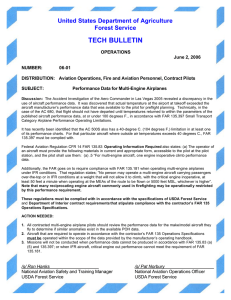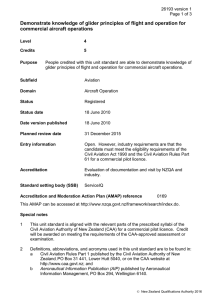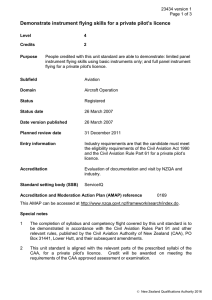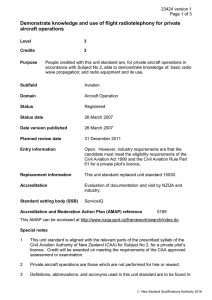Demonstrate competence for multi-engine flight instruction
advertisement
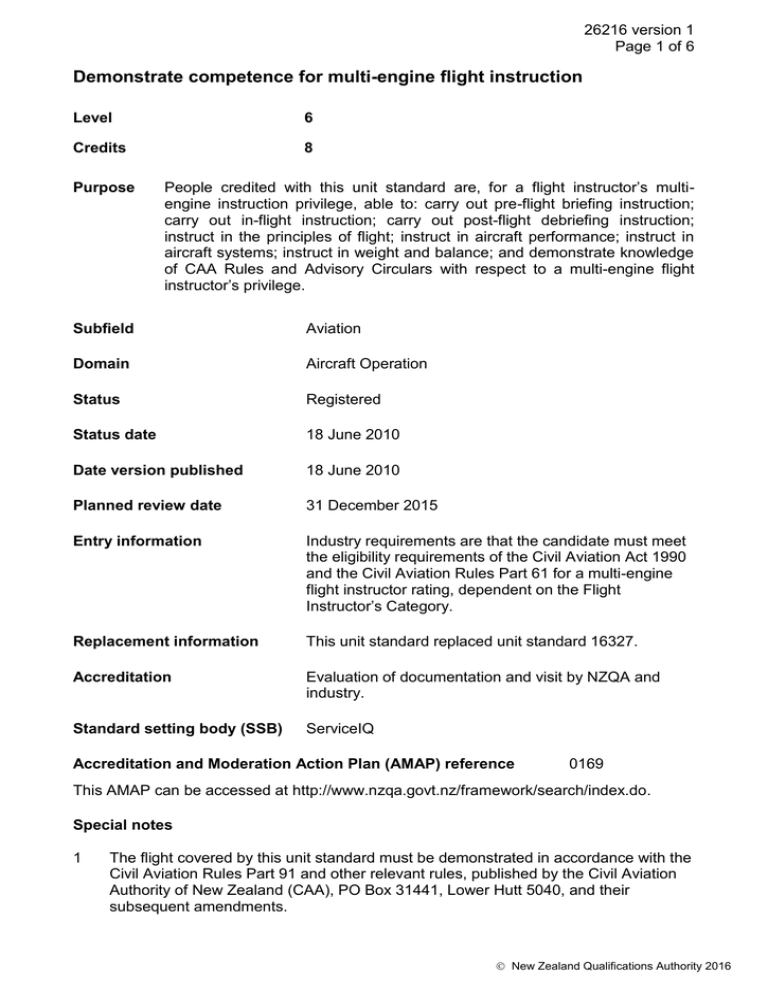
26216 version 1 Page 1 of 6 Demonstrate competence for multi-engine flight instruction Level 6 Credits 8 Purpose People credited with this unit standard are, for a flight instructor’s multiengine instruction privilege, able to: carry out pre-flight briefing instruction; carry out in-flight instruction; carry out post-flight debriefing instruction; instruct in the principles of flight; instruct in aircraft performance; instruct in aircraft systems; instruct in weight and balance; and demonstrate knowledge of CAA Rules and Advisory Circulars with respect to a multi-engine flight instructor’s privilege. Subfield Aviation Domain Aircraft Operation Status Registered Status date 18 June 2010 Date version published 18 June 2010 Planned review date 31 December 2015 Entry information Industry requirements are that the candidate must meet the eligibility requirements of the Civil Aviation Act 1990 and the Civil Aviation Rules Part 61 for a multi-engine flight instructor rating, dependent on the Flight Instructor’s Category. Replacement information This unit standard replaced unit standard 16327. Accreditation Evaluation of documentation and visit by NZQA and industry. Standard setting body (SSB) ServiceIQ Accreditation and Moderation Action Plan (AMAP) reference 0169 This AMAP can be accessed at http://www.nzqa.govt.nz/framework/search/index.do. Special notes 1 The flight covered by this unit standard must be demonstrated in accordance with the Civil Aviation Rules Part 91 and other relevant rules, published by the Civil Aviation Authority of New Zealand (CAA), PO Box 31441, Lower Hutt 5040, and their subsequent amendments. New Zealand Qualifications Authority 2016 26216 version 1 Page 2 of 6 2 This unit standard is aligned with the relevant parts of the prescribed syllabi of the CAA, for a flight instructor’s multi-engine privilege. Credit will be awarded on meeting the requirements of the CAA-approved assessment or examination. 3 Definitions, abbreviations, and acronyms used in this unit standard are to be found in: a Civil Aviation Rules Part 1 published by the Civil Aviation Authority of New Zealand, PO Box 31 441, Lower Hutt 5040, or on the CAA website at http://www.caa.govt.nz; and b Aeronautical Information Publication (AIP) published by Aeronautical Information Management, PO Box 294, Wellington 6140. 4 All references to the CAA refer specifically to the Civil Aviation Authority of New Zealand. 5 Industry standards and recommended practices are those set in place by the CAA. 6 Industry texts may include but are not limited to – aircraft flight manuals, CAA Rules, CAA Advisory Circulars, CAA Flight Test Standards Guides, operator exposition. Elements and performance criteria Element 1 Carry out pre-flight briefing instruction for multi-engine aircraft. Performance criteria 1.1 Pre-flight briefing instruction is carried out in accordance with industry texts and standards. Range 1.2 instruction includes but is not limited to – objectives, principles of flight and considerations, aircraft management, human factors, air exercise. Ground instructional procedures are demonstrated in accordance with industry texts and standards. Range procedures may include but are not limited to – pre-flight briefing delivery, questioning for understanding, use of teaching aids, blackboard and whiteboard technique. New Zealand Qualifications Authority 2016 26216 version 1 Page 3 of 6 Element 2 Carry out in-flight instruction for multi-engine aircraft. Performance criteria 2.1 In-flight instructional procedures are demonstrated in accordance with industry texts and standards. Range procedures include but are not limited to – demonstrate and patter, demonstrate normal and emergency procedures, monitor student practice, identify and correct student faults, maintain situational awareness. Element 3 Carry out post-flight debriefing instruction for multi-engine aircraft. Performance criteria 3.1 Post-flight debriefing instruction is carried out in accordance with industry texts and standards. Range includes but is not limited to – encouraging student self critique, observations, anomalies, remedies, technique, evaluation, student records. Element 4 Instruct in the principles of flight for multi-engine aircraft. Performance criteria 4.1 Instruction in the principles of flight is demonstrated in accordance with industry texts and standards. Range includes but is not limited to – mechanics, airflow, air resistance, lift and drag at subsonic speeds, thrust, level flight, climbing and performance, descending, manoeuvres, stability and control, asymmetry, forces and couples; use and misuse, and limits of rudder, ailerons and elevators; effect of IAS and thrust; residual unbalanced forces; definition, derivation and factors affecting minimum control speed; take-off safety speed; VSSE, VY and VYSE, VX and VXSE; one engine inoperative performance. New Zealand Qualifications Authority 2016 26216 version 1 Page 4 of 6 Element 5 Instruct in aircraft performance for multi-engine aircraft. Performance criteria 5.1 Instruction in aerodrome geometry and take-off flight path is demonstrated in accordance with industry texts and standards. Range 5.2 Instruction in take-off speeds and their effects on aircraft is demonstrated in accordance with industry texts and standards. Range 5.3 includes but is not limited to – VS, VMCA, VYSE, VXSE; relationship between stalling speed and take-off safety speed; ability to interpret take-off data for a typical light multi-engine aircraft and to compute the take-off safety speed in compliance with the regulatory requirements in New Zealand. Instruction in factors affecting take-off and landing distances, and their calculation and use is demonstrated in accordance with industry texts and standards. Range 5.4 includes but is not limited to – runway, stopway, clearway, take-off distance available, landing distance available. factors include but are not limited to – effect of wind, effect of temperature, aircraft all-up weight, aerodrome pressure altitude and runway slope on the takeoff, landing distances; calculations include but are not limited to – ability to use graphs and tabulations for the purpose of calculating these distances, allup weight limitation for an aircraft landing on a surface of fixed length, application of surface correction factors. Instruction in factors affecting aircraft manoeuvring is demonstrated in accordance with industry texts and standards. Range may include but is not limited to – V-g diagram, load factor, Vno, VNE, VA, effect of aeroplane manoeuvre on load factor, turbulence penetration airspeed. New Zealand Qualifications Authority 2016 26216 version 1 Page 5 of 6 Element 6 Instruct in aircraft systems for multi-engine aircraft. Performance criteria 6.1 Instruction in aircraft systems is demonstrated in accordance with industry texts and standards. Range includes but is not limited to – brake systems, hydraulic systems, fuel systems, electrical systems, variable pitch propellers, constant speed units, feathering, general principles and purpose of feathering, pilot checks and inspection systems, vacuum systems, fault finding and analysis, undercarriage, ground power, battery. Element 7 Instruct in weight and balance for multi-engine aircraft. Performance criteria 7.1 Instruction in the effects of weight and balance on aircraft is demonstrated in accordance with industry texts and standards. Range includes but is not limited to – empty weight, zero fuel weight, useful load, maximum all-up weight, balance, centre of gravity, centre of gravity limits and the calculation of the position of the centre of gravity, movement of the centre of gravity due to change of load and fuel burn-off, use of index units. Element 8 Demonstrate knowledge of CAA Rules and Advisory Circulars with respect to a multiengine flight instructor’s privilege. Performance criteria 8.1 Privileges are explained in accordance with CAA Rules and Advisory Circulars. Range 8.2 includes but is not limited to – flight instruction, logbook certification. Limitations are explained in accordance with CAA Rules and Advisory Circulars. Range includes but is not limited to – type rating requirements. Please note Providers must be accredited by NZQA, or an inter-institutional body with delegated authority for quality assurance, before they can report credits from assessment against unit standards or deliver courses of study leading to that assessment. New Zealand Qualifications Authority 2016 26216 version 1 Page 6 of 6 Industry Training Organisations must be accredited by NZQA before they can register credits from assessment against unit standards. Accredited providers and Industry Training Organisations assessing against unit standards must engage with the moderation system that applies to those standards. Accreditation requirements and an outline of the moderation system that applies to this standard are outlined in the Accreditation and Moderation Action Plan (AMAP). The AMAP also includes useful information about special requirements for organisations wishing to develop education and training programmes, such as minimum qualifications for tutors and assessors, and special resource requirements. Comments on this unit standard Please contact the ServiceIQ qualifications@serviceiq.org.nz if you wish to suggest changes to the content of this unit standard. New Zealand Qualifications Authority 2016
